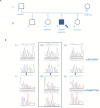Ultrastructural Sperm Flagellum Defects in a Patient With CCDC39 Compound Heterozygous Mutations and Primary Ciliary Dyskinesia/ Situs Viscerum Inversus
- PMID: 33005176
- PMCID: PMC7483550
- DOI: 10.3389/fgene.2020.00974
Ultrastructural Sperm Flagellum Defects in a Patient With CCDC39 Compound Heterozygous Mutations and Primary Ciliary Dyskinesia/ Situs Viscerum Inversus
Abstract
Introduction: Primary ciliary dyskinesia (PCD) is a rare autosomal recessive disease characterized by structural or functional motile cilia abnormalities. Up to 40 different genes seem, at the moment, to be involved in the pathogenesis of PCD. A number of ultrastructural defects have also been reported in sperm flagella, but the sperm mitochondrial membrane potential (MMP) has never been described in these cases. Aim: The aim of this study was to report the sperm MMP and ultrastructural abnormalities of the sperm flagella found in a patient with PCD and situs inversus (Kartagener syndrome) and its characterization from the genetic point of view. Methods: Transmission electronic microscopy (TEM) analysis was used to evaluate flagella ultrastructure. The genetic testing was performed by next-generation sequencing. Sperm DNA fragmentation and MMP were also evaluated by flow cytometry. Results: We report here the case of an 18-year-old male patient with PCD and situs inversus and severe oligo-astheno-teratozoospermia. TEM analysis of his spermatozoa showed an abnormal connecting piece. The mid piece appeared abnormally thickened, with cytoplasmic residue, dysplasia of fibrous sheath, loss of the outer dynein arms (ODAs), truncated inner dynein arms, and supernumerary outer fibers. The percentage of spermatozoa with fragmented DNA was normal, whereas a high percentage of spermatozoa had low MMP, suggesting an altered mitochondrial function. The genetic analysis showed the presence of c.610-2A > G, p.Arg811Cys compound heterozygous mutations in the CCDC39 gene. Conclusion: The case herein reported suggests that the high percentage of sperm with low MMP may play a role in the pathogenesis of asthenozoospermia in patients with Kartagener syndrome. In addition, we report, for the first time, the missense variant p.Arg811Cys in the CCDC39 gene in a patient with Kartagener syndrome. Although in silico analysis predicts its damaging potential, its clinical meaning remains unclear.
Keywords: CCDC151; CCDC39; Kartagener syndrome; asthenozoospermia; primary ciliary dyskinesia; situs inversus.
Copyright © 2020 Cannarella, Maniscalchi, Condorelli, Scalia, Guerri, La Vignera, Bertelli and Calogero.
Figures






Similar articles
-
Biallelic Variants in CCDC39 Gene Lead to Primary Ciliary Dyskinesia and Kartagener Syndrome.Biomed Res Int. 2022 Jun 26;2022:7130555. doi: 10.1155/2022/7130555. eCollection 2022. Biomed Res Int. 2022. PMID: 35795318 Free PMC article.
-
[Cilia ultrastructural and gene variation of primary ciliary dyskinesia: report of three cases and literatures review].Zhonghua Er Ke Za Zhi. 2018 Feb 2;56(2):134-137. doi: 10.3760/cma.j.issn.0578-1310.2018.02.012. Zhonghua Er Ke Za Zhi. 2018. PMID: 29429202 Review. Chinese.
-
A novel CCDC39 mutation causes multiple morphological abnormalities of the flagella in a primary ciliary dyskinesia patient.Reprod Biomed Online. 2021 Nov;43(5):920-930. doi: 10.1016/j.rbmo.2021.07.005. Epub 2021 Jul 22. Reprod Biomed Online. 2021. PMID: 34674941
-
Case report: The CCDC103 variant causes ultrastructural sperm axonemal defects and total sperm immotility in a professional athlete without primary ciliary diskinesia.Front Genet. 2023 Jan 26;14:1062326. doi: 10.3389/fgene.2023.1062326. eCollection 2023. Front Genet. 2023. PMID: 36777727 Free PMC article.
-
CCDC40 mutation as a cause of primary ciliary dyskinesia: a case report and review of literature.Clin Respir J. 2016 Sep;10(5):614-21. doi: 10.1111/crj.12268. Epub 2015 Mar 3. Clin Respir J. 2016. PMID: 25619595 Review.
Cited by
-
Full-length transcriptome analysis of male and female gonads in Japanese Eel (Anguilla japonica).BMC Genomics. 2025 Jan 30;26(1):89. doi: 10.1186/s12864-025-11279-5. BMC Genomics. 2025. PMID: 39885385 Free PMC article.
-
CCDC189 affects sperm flagellum formation by interacting with CABCOCO1.Natl Sci Rev. 2023 Jun 26;10(9):nwad181. doi: 10.1093/nsr/nwad181. eCollection 2023 Sep. Natl Sci Rev. 2023. PMID: 37601242 Free PMC article.
-
Cryo-electron tomography of eel sperm flagella reveals a molecular "minimum system" for motile cilia.Mol Biol Cell. 2025 Feb 1;36(2):ar15. doi: 10.1091/mbc.E24-08-0351. Epub 2024 Dec 11. Mol Biol Cell. 2025. PMID: 39661459 Free PMC article.
-
Metabolic Dysregulation and Sperm Motility in Male Infertility.Adv Exp Med Biol. 2022;1358:257-273. doi: 10.1007/978-3-030-89340-8_12. Adv Exp Med Biol. 2022. PMID: 35641874 Review.
-
Biallelic Variants in CCDC39 Gene Lead to Primary Ciliary Dyskinesia and Kartagener Syndrome.Biomed Res Int. 2022 Jun 26;2022:7130555. doi: 10.1155/2022/7130555. eCollection 2022. Biomed Res Int. 2022. PMID: 35795318 Free PMC article.
References
LinkOut - more resources
Full Text Sources

